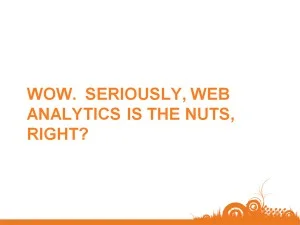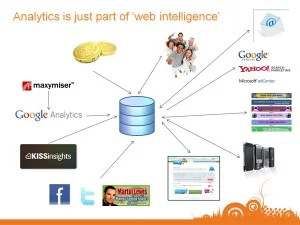My soundtrack begins with Muddy Waters' 'I just want to make love to you', which I find provides an excellent metaphor for the value of web analytics.
Anyway... I cover what web analytics is, how it works, why that's valuable and how you can sell it; also Google Website Optimizer, the Google Analytics partner network, and analytics as part of what we might call 'data solutions'.
It's this last point that I want to cover here. Here's another slide:

Web analytics can quite easily not be the nuts, which you may find surprising. The problem is that without finesse and good use, it's just clickstream data: i.e. a record of the content that your visitors view. At best, this is "the what" of your marketing efforts.
When you use visitor classifications and throw in segmentation techniques, in order to achieve some analysis, you begin to get "the where" and "the how much"; add content testing, like the MVT that you can do with Google Website Optimizer, and it's only then that you'll begin to understand "the why".
And you need "the why": after all web analytics is for making decisions. With clickstream data you might be able to see a series of key metrics and when they change; but you can never act on those metrics until you balance and qualify them with context. Segmentation, then testing, provide that context, "the why", and so "the what next", which allows you to act on the changes in your metrics.
It doesn't stop there. Web analytics at its best has to be part of a data solutions ecosystem. Here's another slide:

When your draw multiple sources of data together into a central place, they can enrich each other, and work together to personalise and time micro-segmented, customer-focused communications and experiences. Here's a (by no means exhaustive) list of data sources:
- Web analytics and content testing
- Voice of customer surveying
- Brand mentions and sentiments (including those of your competitors and their campaigns) scraped from social channels and the web - e.g. twitter, facebook, forums
- Revenue databases, e.g. affiliate click value, and
- CRM databases, including call centre records
When you link these data sources together with common IDs, or simply over time, then the data can work together to operate your marketing channels:
- paid search
- display
- call centre
- in-store
- mobile content
- online content
People get emails that correspond to their behaviour as observed by web analytics. The call centre staff offer a discount that corresponds to the customer's CRM churn risk; and that customer's experience online and in-store is made to correspond too.
This is the stuff that marketing "decision engine" softwares, like Agillic, and, to a lesser extent, Perfomable are doing. It's exciting, most of all because it has the power to make advertising really valuable to the consumer....
So web analytics is the nuts? No, not on its own.
